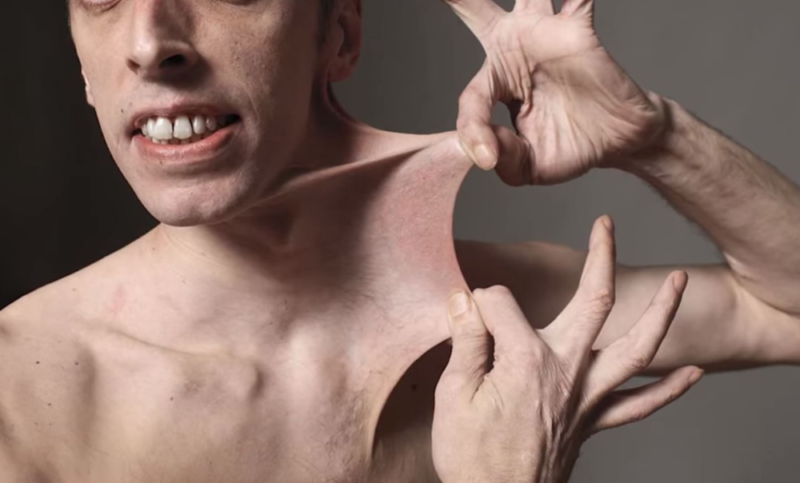Ehlers-Danlos syndrome is considered one of the rare and little-known human diseases. Indeed, people suffering from manifestations of this pathology sometimes have such physiological characteristics that it is just right to be amazed. Joints bending in different directions, the most delicate skin of the body - what other signs are typical for such a unique physiological phenomenon? Learn from this article.
Material Content:
What is Ehlers-Danlos Syndrome
Ehlers-Danlos syndrome is called connective tissue dysplasia, manifested due to the underdevelopment of the collagen structure.
Often, this pathology consists in excessive skin extensibility, frequent bleeding, hypermobility of joints, omission of organs, and so on.
This poorly studied violation is named after the names of two dermatologists who tracked the symptoms of pathology at the beginning of the last century: the Danes E. Ehlers and the Frenchman A. Danlos.
Classification of ailment
Medicine distinguishes 10 types of Ehlers-Danlos syndrome:
- The first type of disorder is recognized as the most frequently monitored (44% of cases). It is called "classic heavy-flow syndrome." In patients with this diagnosis, excessive elasticity, skin vulnerability, and hypermobility of the joints are manifested. The skeleton is often deformed, and pregnancies of women with this pathology often end in miscarriages.
- The second variety is characterized by the above described symptoms of the disease, proceeding to a milder degree.
- The main manifestations of pathology are considered hypermobility of joints and deformation of the musculoskeletal system. Symptoms of skin anomalies of the disease are minimal.
- It is extremely rare, characterized by the severity of the course of the disease. In this case, only articular mobility of the fingers of the upper extremities is noted. The danger lies in the tendency to rupture of blood vessels, hematomas (even internal organs).
- Manifested in hyper-stretch of the skin. Joint hypermobility is moderate.
- In addition to all the symptoms typical of type 1, clubfoot and kyphoscoliosis join the disease.
- This variety is marked by eye syndrome (there is glaucoma, myopia, strabismus, etc.).
- Patients are characterized by small stature and hypermobile joints.
- The fragility of the skin is accompanied by periodontitis - patients lose their teeth early.
- It is characterized by superelastic skin, mobile joints and frequent manifestations of stretch marks. In patients, repeated cases of dislocation of the shoulder or patella are monitored.
Note. Type 9 is excluded from the classification of varieties of the syndrome.
Light forms of the rare Ehlers-Danlos pathology are also known to medicine. Their manifestations are insignificant. The prevalence of moderate pathology is 1 case per 5,000 babies born, while a severe form is 1 case per 100,000.
Causes of pathology
The basis of the syndrome is biochemical defects that provoke a pathology of collagen synthesis.
Modern medicine has studied the mechanisms of occurrence of not all varieties of the syndrome. Only a few of them have been investigated in detail:
- It is believed that the first type is due to a decrease in the activity of fibroplasts and a deficiency of enzymes that trigger collagen synthesis.
- Type 4 is associated with type 3 collagen deficiency.
- Type 6 is monitored as a result of an insufficient amount of the enzyme lysyl hydroxylase.
- Type 7 is characterized by the conversion of type 1 procollagen to collagen.
- 10 type of pathology is characterized by malfunctions in the organization of the intracellular matrix.
Each type of pathology is caused by a mutation of a particular human gene.
The main clinical manifestations and symptoms
Symptoms of the syndrome vary according to the type of disorder and inheritance. All signs are distinguished by a generalized nature.
However, the main clinical manifestations of Ehlers-Danlos syndrome can be distinguished:
- Skin manifestations. They are hypersensitivity to the skin. It is easily pulled, forming a crease. The integument is smooth and velvety, wrinkling on the palms, feet. This sensitivity is monitored from birth to school age, decreasing over time. This also includes fragility and vulnerability of the skin, observed from 3 years. Even the most harmless injuries form non-healing wounds that transform into atrophic or keloid scars.
- Joint manifestations. The so-called looseness or hypermobility of the joints. May be local or generalized. Joint syndrome begins to be monitored when the child takes the first steps, which provokes the repetition of dislocations and subluxations. Over time, joint mobility may decrease.
- Cardiovascular manifestations. Persons prone to Ehlers-Danlos syndrome often suffer from congenital heart defects, cerebral aneurysms, bleeding, and there is a tendency to form hematomas.
- Eye manifestations. They consist in hyperelasticity of the skin of the eyelids, their omission, rupture of the cornea, strabismus, etc.
- Skeleton deformation. In patients, a keeled or funnel-shaped sternum is diagnosed, scoliosis, kyphosis are detected, hernias, ptosis of internal organs are monitored.
On a note. Ehlers-Danlos syndrome in children does not affect the brain. The child develops according to age.
Diagnostic measures
Diagnosis of Ehlers-Danlos syndrome is carried out by a geneticist, taking into account the clinical history and genealogical data.
Certain forms may require a skin biopsy, electron microscopy and histochemical, histological studies.
Since the symptoms typical for pathology are joint hypermobility or high skin extensibility, the main diagnostic measure is to assess the condition of the musculoskeletal system. The specialist monitors the degree of extensibility of the joints and the extension of the integument.
In order to track the condition of internal organs and prevent their omission, ultrasound, ECG, CT are recommended for the patient.
Treatment of a rare disease
Unfortunately, there is no cure for the cause of the syndrome. Patients are shown exclusively symptomatic therapy, depending on the type of pathology.
Patients with a diagnosis of Ehlers-Danlos should pay close attention to their diet, including protein-rich foods, as well as various jellies, jellied dishes and bone broths.
In addition, such patients should reduce physical activity, doing physical therapy and practicing massage and physiotherapy.
With regard to drug therapy of the disease, patients may be prescribed:
- chondroprotectors (improve the metabolic processes of cartilage);
- amino acids;
- vitamin complexes (in particular, groups B, C, E, D).
Treatment lasts 30-40 days and should be comprehensive. Treatment courses should be carried out 2-3 times a year. Certain cases require surgical intervention.
Prognosis for people with connective tissue dysplasia
The quality of life of patients diagnosed with Ehlers-Danlos, as well as its duration, depends on the form of pathology. Type 4 is considered the most dangerous for humans - a tragic outcome with it is recorded most often. Type 1 greatly limits the quality of life of the patient. The most favorable are 2 and 3 types of syndrome.
Ehlers-Danlos syndrome is combined with many difficulties, in particular social ones, for example, it limits the choice of a profession and also prohibits certain types of physical activity.
But there are people who were able to succeed, despite the diagnosis. One of the most famous and successful girls with Ehlers-Danlos syndrome is Victoria Graham, a student at the American Manchester. As a child, she was actively involved in gymnastics, but after receiving a minor injury, she began to have health problems. For a long time, no one could diagnose the cause of excessive mobility in Victoria's joints and excessive tenderness of her skin. Finally, at the age of 13, genetics diagnosed her with Ehlers-Danlos syndrome. By the age of 22, the girl underwent more than 10 operations on the spine and brain, after which a noticeable crimson scar began to cross most of her back. But this does not prevent Victoria from leading an active life and even becoming the winner of several beauty contests. The girl has to take a large number of drugs every 2 hours to reduce the manifestations of pain. In addition, Victoria adheres to a strict diet to prevent ptosis of internal organs. Looking at the photo of a smiling cheerful blonde, it is difficult to imagine how many trials she had to endure. Only a few photos that show a vertical scar in the spine and protruding clavicles of a girl can trace the symptoms of Ehlers-Danlos syndrome. However, the student is not discouraged, optimistic about the future, and even organized her own fund to support patients with the same ailment as hers.
Is there prevention
Prevention of Ehlers-Danlos syndrome consists in a complete rejection of contact sports and activities associated with high articular load. You can reduce the risk of rupture of blood vessels by using regular monitoring of blood pressure.
Patients should choose professions that do not put a strain on the spine and legs. In order to protect the joints, it is recommended to wear special bandages, use helmets, knee pads and elbow pieces during physical activity.
Tip. If you suspect Ehlers-Danlos syndrome in yourself or a loved one, you should immediately contact a therapist or pediatrician. In addition, a visit to narrow specialists is required - a dentist, a vascular surgeon, a dermatologist, a rheumatologist and so on.
Cases of the detection of Ehlers-Danlos syndrome are infrequent - this pathology is monitored in rare patients. Each variety of this disease may have certain symptoms, and yet most of the symptoms are basic, typical. Therapy of an unusual physiological state is complicated by the lack of specially designed treatment, since the syndrome is considered a congenital pathology.



















